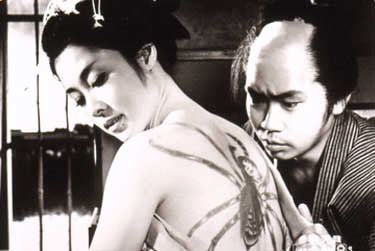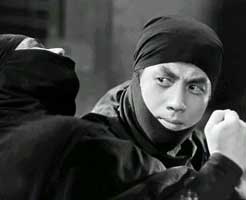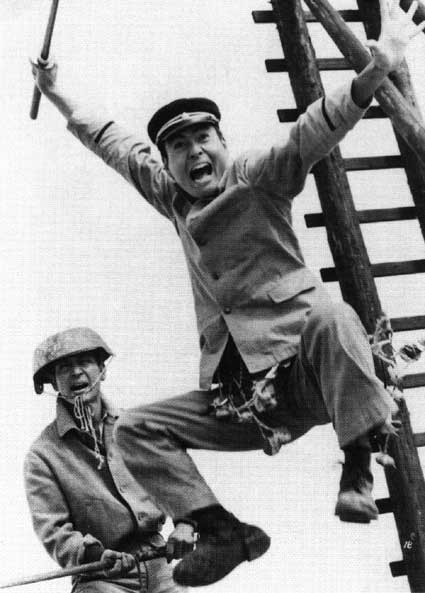
at the Museum of Modern Art, New York
September 2005-January 2006
By Michael Wells
Part 3
It pains me to look at my third and final installment: seven films,
or only five if you count the three shorts shown together as one.
This makes a total of fifteen (or twelve) movies that I saw, out of the
fifty-plus in the series. I must beg your forgiveness, dear reader,
for what turns out to be the paltriness of my final report. But you
know how real life can get in the way of going to the movies sometimes.
In my defense, I also blame the museum’s decision to program a series of
classic Chinese films opposite their series of classic Japanese films (report
on that one coming soon!). All that said, enjoy, and try not to grind
your teeth too much over the ones you’ll never get to see. Heh, heh.
This flamboyantly nihilistic, erotic costume thriller from one of the bad boys of ‘60s Japanese cinema provides a good example of the interesting associations that can arise when you view so many films in such a short time. After seeing a number of mild-mannered movies about the national predilection for social accommodation and respect for tradition, it’s bracing to watch one that spits and scratches at the face of such proprieties with such bad-mannered fury. The titular body decoration (and it’s a doozy) is spread across the silky back of a beautiful and spunky young woman from a middle-class merchant family who is abducted into geisha work. Clearly not having seen enough Ozu, she takes advantage of her situation, and the think-with-your-penis stupidity of virtually every man she encounters, to wreak bloody vengeance. The ugliness of the premise is turned to beauty by the film’s black humor and sensuality: in what seems like almost every shot, Masumura puts to retina-singeing use an astonishingly varied palette of primary colors, without stumbling into garishness. The story is another matter, garish and perverse and gleefully proud of it. Moral clarity obviously isn’t this filmmaker’s bag, but Irezumi seems to be on the side of the underdogs’ right (obligation?) to bite back hard at any opportunity. Any explicitly feminist leanings are muddied by the movie’s ambivalence towards its antiheroine and its drooling fetishization of her body and face (not to mention a rather conventionally moralistic ending). Anyone who wants to accuse Masumura of misogyny might have half a case, but they’d have to contend first with the movie’s far more intense misandrony.

An oddly dissonant experience for this Yankee moviegoer’s brain, this looks like a classic samurai film in its obviously big budget production and crisp, black and white widescreen. But it feels more like a Hong Kong wuxia fantasy, with its rivalry between secret sects of Buddhist mystics and its gravity-defying leaps and running up walls. (An aside on the always fascinating vagaries of translation: The mystics are referred to in the subtitles by the rather vague term “occultists,” even though the word uttered by the actors is clearly “ninja.” Supposedly all the subs in this series are new translations, so it’s hard to account for the avoidance of a term well-known to current American audiences.) It’s pretty pokey and despite its lavishness, doesn’t have much real visual flair. Fairly little is made of the most intriguing and suggestive plot twist, which seems like it ought to signal an amping up of the narrative’s intensity, but instead turns out as a brief jump of the needle before it settles back into its customary drone. The story (cocky young hero discovers the secret corruption within his ninja clan’s leadership, turns his back on the whole martial arts world, falls in love, finds that “just when he thinks he’s out, they pull him back in”) likewise suggests a humanistic skepticism. But only in isolated moments does this break through the general feeling of slightly bored familiarity. The series catalog says that the director was a noted leftist filmmaker, and describes this film as a bold revisionist take on a then-popular subgenre – having seen none of the counterexamples, I can’t vouch for the credibility of this interpretation, but there it is, take it or leave it.

The smell of sweat and the feel of grime on the
skin are given off by this chambara movie with an authenticity that seems
to foreshadow Kurosawa’s later classics (which is not to say that the director
comes close to Kurosawa’s mastery of rhythm and composition). The
hero is a samurai unjustly accused of treason who joins with and eventually
leads a motley pack of thieves and lowlifes in a Robin Hood existence of
terrorizing the feudal overlords and comforting the poor. It actually
echoes Band of Assassins (above) and many other movies in its portrait
of a warrior who is thrust outside of his subculture by treachery and takes
up arms against its injustices (what might cynically be called the “sour
grapes” action formula). Both movies are a little bit too pat and
a little too scrupulous about following formula to meet the full potential
of such a premise. Bandits seems to be onto something when
the hero begins to have trouble getting “his” bandits to follow chivalrous
rules of engagement (like, you know, don’t rape the women) and they start
to complain that his gentlemanly standards are keeping them from making
a living. But it doesn’t do much with the idea, which just turns
out as a bump on their road to righteous glory.
Digest versions of feature films, made for the home viewing market, were apparently quite commonplace in early Japanese cinema – sort of a cross between Cliffs Notes and the home video market that sustains the Japanese industry today. These three silents, shown together, only exist in their truncated forms, which is a shame in two cases and (though I know I shouldn’t say it) merciful in another.
Yasujiro Ozu’s Fighting Friends, Japanese Style (1929, 14 minutes) is a buddy comedy in which two poor-but-jolly bachelor roommates give shelter to a pretty, demure young homeless woman and start competing for her attentions like a pair of thirteen-year-old boys. These fragments show a finely judged balance of character comedy, mild slapstick and sentiment. Like classic Chaplin, it’s surprisingly forthright about the little, grinding indignities of poverty without losing a defiantly sunny tone. It’s also an enlightening look at how adept young Ozu was at working with more conventional cinematic grammar, before he became the king of long takes, tatami-mat-level eyelines, etc.
Torajiro Saito’s A Buddhist Mass for Goemon Ishikawa (1930, 21 minutes), a rambunctious farce featuring young love thwarted by parental opposition and then rescued by ghosts fake and real, isn’t a lot longer, but feels like it is. It’s one of those comedies where the characters’ frantic actions are both so nasty and so divorced from convincingly human behavior that it was tough for me to sympathize, or laugh, with any of them. The flat, stagey filmmaking doesn’t add any pep to the laborious goings-on. In theory, a lot of saving graces could have been lost in the cutting room, but I doubt it. Most or all of the story seemed to be there, and unfunny movies don’t tend to get funnier if you triple or quadruple their lengths.
Would that I could have seen another twenty-one
minutes, or even one, of Mikio Naruse’s Ode to a Salesman (1931,
38 minutes). It’s by far the longest of the three, as if even the
cutters hired to mutilate these movies couldn’t stand to chop any more
of this lovely piece of work. It’s a seriocomic slice-of-life look
at a door-to-door insurance hawker, whose anxious concern for the respect
of the neighbors affects his relationship with his meek, bullied little
son. Ode is funny in a down-to-earth, unselfconscious way.
It pokes fun at the title character’s pretensions and the contrast between
what he wants to be his high ideals and his often underhanded and self-degrading
actions; yet it maintains an affectionate attitude. It also features
the oft-noted Japanese gift for dramatizing the petty miseries and social
slights of childhood, particularly as lived in such a hierarchical and
conformist society. When it turns toward tearjerking melodrama in
the final act, I didn’t feel any strain at all, so totally had Naruse invested
me in his characters, and so deftly does he infuse the heretofore naturalistic
visuals with emotion-heightening expressionistic devices. Sorry to
say, this is the first and so far only Naruse I’ve laid eyes on; I have
a feeling from what I’ve read about him that it’s rather far removed from
his later, more restrained style. But it’s clear that this is a true
semi-lost classic. Thank heavens for the scissor-wielders, or else
we might not have any of it.
I’ve generally found the films of Suzuki overrated significantly, but this one feels more vital and substantive than any of the other three I’ve seen from him. It takes the grim subject of the rise of militarism in pre-World War II Japan into the realm of rambunctious satire without sacrificing a sense of tragedy. The main character is an essentially well-meaning but aimless youth who finds an outlet in hand-to-hand gang warfare. While far from subtle, the movie lays out a fairly complicated picture of the protagonist’s motivations and impulses. It insists particularly on sexual repression as an element, allowing for some erection and masturbation innuendoes that must have seemed pretty outrageous in ’66 but are almost quaint in our Farrelly Brothers era. The numerous fight scenes and gang rumbles are a hoot, slapsticky and chaotic, stylized but without the glamorous grace of generic action movies. Suzuki keeps his characteristic left turns into “WTF?” goofball surrealism to a level where they never start yielding diminishing returns. And his eye is as exquisite as ever, the widescreen black and white images both diamond-cutter sharp and glowing like milky moonlight. The satirical points Suzuki makes aren’t always clear to a non-Japanese viewer (I might have been lost if I hadn’t read up on the film a little beforehand). Sometimes I wondered if they were “muddled” or “nuanced” or just over my head. As Born Fighter proceeds, though, one intriguing central idea seems to develop: that the anarchic violence of the hero and his gang buddies is fairly harmless (after all, they only turn it on each other, and it’s never fatal) and even contains a healthy anti-authoritarian streak. That is, until it’s channeled in a proto-fascist direction by the same adult authority figures who used to condemn it when they couldn’t control it. That the point isn’t terribly clear might be the filmmaker’s problem, or mine, or even none at all. At any rate, it’s the first Suzuki I feel I’ll watch again.

Michael Wells can be contacted here.